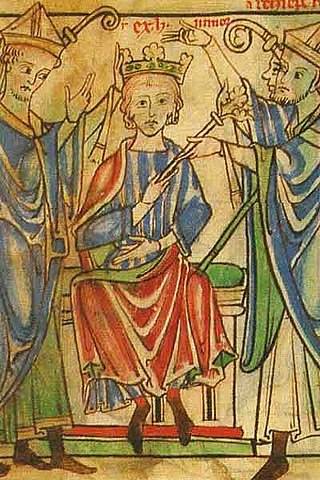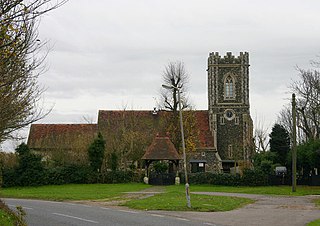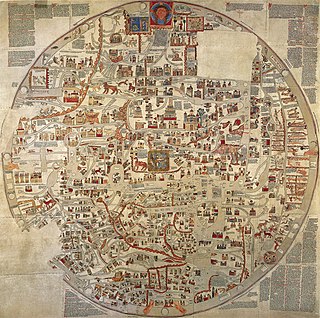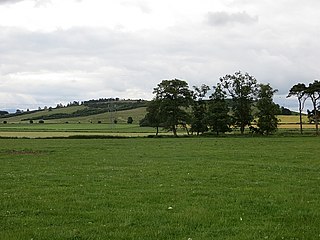
Saint Veronica, also known as Berenike, was a widow from Jerusalem who lived in the 1st century AD, according to extra-biblical Christian sacred tradition. A celebrated saint in many pious Christian countries, the 17th-century Acta Sanctorum published by the Bollandists listed her feast under July 12, but the German Jesuit scholar Joseph Braun cited her commemoration in Festi Marianni on 13 January.

Henry the Young King was the eldest son of Henry II of England and Eleanor of Aquitaine to survive childhood. In 1170, he became titular King of England, Duke of Normandy, Count of Anjou and Maine. Henry the Young King was the only English king since the Norman Conquest to be crowned during his father's reign, but he was frustrated by his father's refusal to grant him meaningful autonomous power. He died aged 28, six years before his father, which left his brother Richard to become the next king.
This article contains information about the literary events and publications of the 13th century.

A mappa mundi is any medieval European map of the world. Such maps range in size and complexity from simple schematic maps 25 millimetres or less across to elaborate wall maps, the largest of which to survive to modern times, the Ebstorf map, was around 3.5 m in diameter. The term derives from the Medieval Latin words mappa and mundus (world).
Gervase of Tilbury was an English canon lawyer, statesman and cleric. He enjoyed the favour of Henry II of England and later of Henry's grandson, Emperor Otto IV, for whom he wrote his best known work, the Otia Imperialia.
The earliest known world maps date to classical antiquity, the oldest examples of the 6th to 5th centuries BCE still based on the flat Earth paradigm. World maps assuming a spherical Earth first appear in the Hellenistic period. The developments of Greek geography during this time, notably by Eratosthenes and Posidonius culminated in the Roman era, with Ptolemy's world map, which would remain authoritative throughout the Middle Ages. Since Ptolemy, knowledge of the approximate size of the Earth allowed cartographers to estimate the extent of their geographical knowledge, and to indicate parts of the planet known to exist but not yet explored as terra incognita.
Gervase is a masculine given name which may refer to:

West Tilbury is a village and former civil parish in the Thurrock district, in the ceremonial county of Essex, England. It is on the top of and on the sides of a 30 metres (98 ft) tall river terrace overlooking the River Thames. Part of the modern town of Tilbury is within the traditional parish of West Tilbury. In 1931 the parish had a population of 444. On 1 April 1936 the parish was abolished to form Thurrock.

The Ebstorf Map was an example of a mappa mundi. It was made by Gervase of Ebstorf, who was possibly the same man as Gervase of Tilbury, some time between 1234 and 1240.

King Arthur's messianic return is a mythological motif in the legend of King Arthur, which claims that he will one day return in the role of a messiah to save his people. It is an example of the king asleep in mountain motif. King Arthur was a legendary 6th-century British king. Few historical records of Arthur remain, and there are doubts that he ever existed, but he achieved a mythological status by High Middle Ages that gave rise to a growing literature about his life and deeds.

Various species of mythical headless men were rumoured, in antiquity and later, to inhabit remote parts of the world. They are variously known as akephaloi or Blemmyes and described as lacking a head, with their facial features on their chest. These were at first described as inhabitants of ancient Libya or the Nile system (Aethiopia). Later traditions confined their habitat to a particular island in the Brisone River, or shifted it to India.
Germanus II Nauplius was Patriarch of Constantinople from 1223 until his death in June 1240.

Wandlebury Hill Fort, also known as the Wandlebury Ring, is an Iron Age hillfort located on Wandlebury Hill in the Gog Magog Hills, Cambridgeshire, England, to the southeast of Cambridge. Now a country park, it was the most important of three hillforts in the downs.

Otia Imperialia is an early 13th-century encyclopedic work, the best known work of Gervase of Tilbury. It is an example of speculum literature. Also known as the "Book of Marvels", it primarily concerns the three fields of history, geography, and physics, but its credibility has been questioned by numerous scholars including philosopher Gottfried Leibniz, who was alerted to the fact that it contains many mythical stories. Its manner of writing is perhaps because the work was written to provide entertainment to Holy Roman Emperor Otto IV. However, many scholars consider it a very important work in that it "recognizes the correctness of the papal claims in the conflict between Church and Empire." It was written between 1210 and 1214, although some give the dates as between 1209 and 1214 and numerous authors state it was published c.1211. These earlier dates must be questioned, however, as the Otia contains stories that take place in 1211 and later. S. E. Banks and James W. Binns, editors and translators of what is considered to be the definitive version of the Otia, suggest that the work was completed in the last years of Otto IV's life, saying "it seems most likely [...] that the work was sent to Otto sometime in 1215", due to the inclusion of the death of William the Lion, King of Scotland, which took place in 1214, and the fact that King John was still living while it was written; John died in 1216.
Carl Rümpler was a German publisher, based in Hanover. He and his publishing company of the same name published a high number of works in the 1850s–1870s. He published many books related to myths and tales such as Gervase of Tilbury's medieval encyclopedia Otia Imperialia in 1856, he also published works such as Herman Grimm's Leben Michelangelo in two volumes between 1860 and 1863 amongst many others.
De situ terrae sanctae is a short 6th-century report of a pilgrimage to the Holy Land. Its author is identified in a 9th-century manuscript as a German archdeacon named Theodosius.

John of Antioch, also known as Harent of Antioch, was a 13th-century Old French writer of Outremer who made important translations from Latin. He translated Cicero, Boethius, the Otia imperialia and possibly the rule of the Knights Hospitaller. His original writing consists of an epilogue to Cicero and some additional chapters appended to the Otia.

Jean de Vignay (c. 1282/1285 – c. 1350) was a French monk and translator. He translated from Latin into Old French for the French court, and his works survive in many illuminated manuscripts. They include two military manuals, a book on chess, parts of the New Testament, a travelogue and a chronicle.

The airship of Clonmacnoise is the subject of a historical anecdote related in numerous medieval sources. Though the original report, in the Irish annals, simply mentioned an apparition of ships with their crews in the sky over Ireland in the 740s, later accounts through the Middle Ages progressively expanded on this with picturesque details. First the ships were reduced to one ship over Teltown from which a crewman threw and then recovered a fishing-spear. Then the scene shifted to the abbey of Clonmacnoise, and later to Britain, and the fishing-spear was changed to an anchor which snagged on some feature of a church. The sailor who climbed down to release it was also said to be in danger of drowning in the thicker air of this lower world. The story was retold by Seamus Heaney in a well-known poem collected in his 1991 volume, Seeing Things.

Tarn Wadling was a lake between Carlisle and Penrith, near the village of High Hesket in Cumbria, England. In the Middle Ages, it was famous for its carp, but it was drained in the 19th century, and is now no more than a depression. The name remains today in a small woodland governed by the Woodland Trust.













